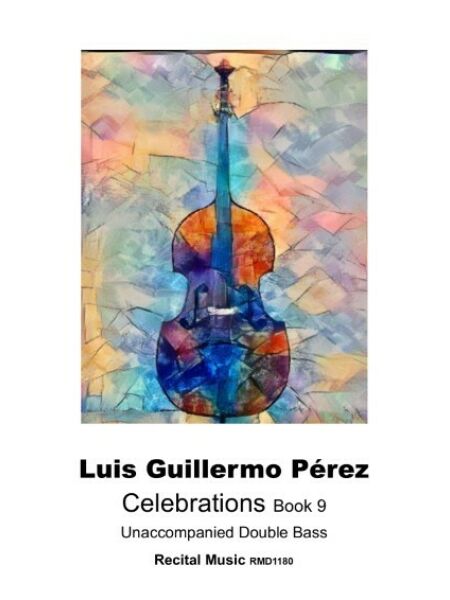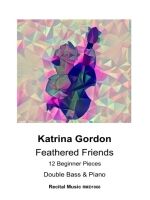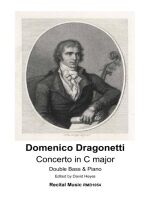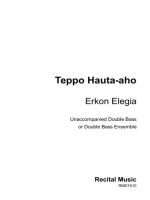Celebrations Book 9

Product code:
£10.00
Description
Celebrations Book 9 brings together ten exciting, evocative and inventive works for unaccompanied double bass by the Venezuelan composer-bassist Luis Guillermo Pérez. Composed between 2018 and 2021, written for a specific bassist, commemoration or anniversary, all are aimed at the adventurous and progressing intermediate bassist.
Each piece offers musical and technical challenges in equal measure, exploring the entire range of the double bass, in a colourful and expressive musical language. Modern and tonal, contemporary yet accessible, none of them outstay their welcome, and create a new repertoire which offers much to performers and audiences alike.
Ascensión – composed in 2018 to commemorate the 100th anniversary of the death of
Claude Debussy (1862-1918)
Ascensión is a monothematic piece structured in three parts. The first part is in the key of E
minor, until bar 18. The first phrase starts with the interval of a descending fifth played
pizzicato, which represents the material life, immediately followed by an arco melody in
harmonics, which always ends on high-pitched sounds and forte, hence the name of the
piece. The second phrase is 4 bars long and is a variation of the first, the same for the third
and fourth phrase until bar 16, and the last two bars are codettas corresponding to this
section. The second part with the initial theme in variation goes by G, Eb and Db, and the
descending fifth motifs return in pizzicato and new motifs, with descending scales (veloce),
appear. This section ends in the bar 41. The third part is a re-exposition of the first 8 bars
from the beginning, and from bar 50 to 54 is the final codetta, which is a melody elaborated
by four notes of the double bass in three registers and ascending to the highest notes,
symbolizing the arrival to heaven, finishing with three strikes from the destiny in diminishing
pizzicatos. (LGP]
Celebration – composed in March 2021 for Teppo & Frank @ 80 to celebrate the 80th
birthdays of Teppo Hauta-aho (1941-2021).
I wrote this piece thinking about works such as Sonata ‘1963’ and the Carmen Fantasy by
Frank Proto, I also wanted to make it free, like Kadenza by Teppo Hauta-aho. In the
introduction (part A), resonant arpeggios are played pizzicato, with small arco interventions,
this first part is free and rhapsodic, with passages, slowing and accelerating. Then begins a
faster section (part B) which is a rhythmic dance with brackets grouped into three and four
accents, given by the changes of the compass, repeating the theme to octaves and
culminates with a small coda (Solemmne) in two-part chords and played forte. [LGP]
Reverence – composed in March 2021 to celebrate the 90th birthday of the iconic
double bass virtuoso François Rabbath
Reverence is free and rhapsodic, exploring the lyrical solo register of the double bass with
music which emphasises the sonorous qualities of the instrument. An eight bar introduction
leads into music which is song-like and expressive, contrasting free flowing semiquavers
which create movement and momentum. A series of double stops and harmonics add colour
and interest before the opening music returns, but now an octave higher. [David Heyes]
Bertday – composed in 2018 to celebrate the 85th birthday of the legendary
American contemporary soloist Bertram [Bert] Turetzky
Bertday is a lively, vibrant and colourful tribute to the great Bertram Turetzky on his 85th
birthday. There is a rhythmic energy and momentum throughout, employing effective double
stops, glissandi and recurring motifs and short phrases which create both contrast and unity.
Bertday uses the entire range of the solo double bass, with the lowest string tuned down to
D, and is effective, evocative and exciting in performance. [DH]
Self-Portrait – composed in December 2020 for Self-Portrait 2021
Marked Moderato and molto legato, Self-Portrait is written in the form of a study and is
predominantly in the key of E flat major, using quarter notes (crotchets) with melodies
comprising the interval of a third, and using a silences to give impetus to ascending
dissonant intervals that generate a feeling of anguish. The title Self-Portrait justified this
because through music I have tried to portray the mood of a morning at home on 27
December 2020. [LGP]
A Tribute to Tony Osborne – composed in 2020 in memory of English bassist-
composer Tony Osborne (1947-2019)
At the behest of David Heyes, I composed Tribute to the memory of Tony Osborne who was
a double bassist, teacher and composer. The piece is written for unaccompanied double
bass with an A-B-A structure, Larghetto Afetuosso (A) with motifs from the Eccles Sonata, in
the first 2 phrases, followed by a Molto piú mosso in Bb major with a retrograde motif from
the second movement of the Eccles Sonata, but with a change of character, then returning
to the initial tempo. Thank you endlessly to David Heyes for inviting me to be part of this
project with many days of quarantine making the days longer and more productive. God
protect us all. [LGP]
Four Pieces for Leonardo – composed for Da Vinci 500 in 2018 to commemorate
the 500th anniversary of the death of Leonardo da Vinci (1452-1518)
1. Search (Ricercar): Ricercar in Italian means to search and is a musical predecessor of the
fugue which appeared in the Baroque. It consisted of a phrase that was enriched but always
conserving the initial motives, developing or expanding them using the different types of
imitations. I considered it prudent to start this group of 4 pieces, assuming that da Vinci’s
genius would use those first ideas to develop his inventions and also his artistic works.
2. Recurring Ideas (Interlude): The artist in his creative process uses small ideas, which in
music we call motives, these are repeated again and again turning in our mind, often
tormenting us, until we get an order or balance and the final work appears. In the case of a
genius such as Leonardo da Vinci, masterpieces, some or many of them questioned, others
are visionary or prophetic.
3. Alchemy – Although in his notebook da Vinci criticised the pretension of man in imitating
nature and trying to produce gold from other metals, he was considered by some as an
alchemist, esoteric and belonging to a circle or sects of elect, as happened with other
geniuses in different countries. The geniuses transform the coarsest and simple into gold
and into wonders and they are true magicians in all the disciplines that entered. This piece
presumes to describe in sound this side of the Italian genius.
4. Bird Man – da Vinci believed that man could fly, making the study of birds in their anatomy
and the physics of flight, which is shown by his inventions and plans considered as
precursors of flying ships of our day. This brief study simulates with sounds and speed the
flutter of a bird’s flight. [LGP]
Description
Celebrations Book 9 brings together ten exciting, evocative and inventive works for unaccompanied double bass by the Venezuelan composer-bassist Luis Guillermo Pérez. Composed between 2018 and 2021, written for a specific bassist, commemoration or anniversary, all are aimed at the adventurous and progressing intermediate bassist.
Each piece offers musical and technical challenges in equal measure, exploring the entire range of the double bass, in a colourful and expressive musical language. Modern and tonal, contemporary yet accessible, none of them outstay their welcome, and create a new repertoire which offers much to performers and audiences alike.
Ascensión – composed in 2018 to commemorate the 100th anniversary of the death of
Claude Debussy (1862-1918)
Ascensión is a monothematic piece structured in three parts. The first part is in the key of E
minor, until bar 18. The first phrase starts with the interval of a descending fifth played
pizzicato, which represents the material life, immediately followed by an arco melody in
harmonics, which always ends on high-pitched sounds and forte, hence the name of the
piece. The second phrase is 4 bars long and is a variation of the first, the same for the third
and fourth phrase until bar 16, and the last two bars are codettas corresponding to this
section. The second part with the initial theme in variation goes by G, Eb and Db, and the
descending fifth motifs return in pizzicato and new motifs, with descending scales (veloce),
appear. This section ends in the bar 41. The third part is a re-exposition of the first 8 bars
from the beginning, and from bar 50 to 54 is the final codetta, which is a melody elaborated
by four notes of the double bass in three registers and ascending to the highest notes,
symbolizing the arrival to heaven, finishing with three strikes from the destiny in diminishing
pizzicatos. (LGP]
Celebration – composed in March 2021 for Teppo & Frank @ 80 to celebrate the 80th
birthdays of Teppo Hauta-aho (1941-2021).
I wrote this piece thinking about works such as Sonata ‘1963’ and the Carmen Fantasy by
Frank Proto, I also wanted to make it free, like Kadenza by Teppo Hauta-aho. In the
introduction (part A), resonant arpeggios are played pizzicato, with small arco interventions,
this first part is free and rhapsodic, with passages, slowing and accelerating. Then begins a
faster section (part B) which is a rhythmic dance with brackets grouped into three and four
accents, given by the changes of the compass, repeating the theme to octaves and
culminates with a small coda (Solemmne) in two-part chords and played forte. [LGP]
Reverence – composed in March 2021 to celebrate the 90th birthday of the iconic
double bass virtuoso François Rabbath
Reverence is free and rhapsodic, exploring the lyrical solo register of the double bass with
music which emphasises the sonorous qualities of the instrument. An eight bar introduction
leads into music which is song-like and expressive, contrasting free flowing semiquavers
which create movement and momentum. A series of double stops and harmonics add colour
and interest before the opening music returns, but now an octave higher. [David Heyes]
Bertday – composed in 2018 to celebrate the 85th birthday of the legendary
American contemporary soloist Bertram [Bert] Turetzky
Bertday is a lively, vibrant and colourful tribute to the great Bertram Turetzky on his 85th
birthday. There is a rhythmic energy and momentum throughout, employing effective double
stops, glissandi and recurring motifs and short phrases which create both contrast and unity.
Bertday uses the entire range of the solo double bass, with the lowest string tuned down to
D, and is effective, evocative and exciting in performance. [DH]
Self-Portrait – composed in December 2020 for Self-Portrait 2021
Marked Moderato and molto legato, Self-Portrait is written in the form of a study and is
predominantly in the key of E flat major, using quarter notes (crotchets) with melodies
comprising the interval of a third, and using a silences to give impetus to ascending
dissonant intervals that generate a feeling of anguish. The title Self-Portrait justified this
because through music I have tried to portray the mood of a morning at home on 27
December 2020. [LGP]
A Tribute to Tony Osborne – composed in 2020 in memory of English bassist-
composer Tony Osborne (1947-2019)
At the behest of David Heyes, I composed Tribute to the memory of Tony Osborne who was
a double bassist, teacher and composer. The piece is written for unaccompanied double
bass with an A-B-A structure, Larghetto Afetuosso (A) with motifs from the Eccles Sonata, in
the first 2 phrases, followed by a Molto piú mosso in Bb major with a retrograde motif from
the second movement of the Eccles Sonata, but with a change of character, then returning
to the initial tempo. Thank you endlessly to David Heyes for inviting me to be part of this
project with many days of quarantine making the days longer and more productive. God
protect us all. [LGP]
Four Pieces for Leonardo – composed for Da Vinci 500 in 2018 to commemorate
the 500th anniversary of the death of Leonardo da Vinci (1452-1518)
1. Search (Ricercar): Ricercar in Italian means to search and is a musical predecessor of the
fugue which appeared in the Baroque. It consisted of a phrase that was enriched but always
conserving the initial motives, developing or expanding them using the different types of
imitations. I considered it prudent to start this group of 4 pieces, assuming that da Vinci’s
genius would use those first ideas to develop his inventions and also his artistic works.
2. Recurring Ideas (Interlude): The artist in his creative process uses small ideas, which in
music we call motives, these are repeated again and again turning in our mind, often
tormenting us, until we get an order or balance and the final work appears. In the case of a
genius such as Leonardo da Vinci, masterpieces, some or many of them questioned, others
are visionary or prophetic.
3. Alchemy – Although in his notebook da Vinci criticised the pretension of man in imitating
nature and trying to produce gold from other metals, he was considered by some as an
alchemist, esoteric and belonging to a circle or sects of elect, as happened with other
geniuses in different countries. The geniuses transform the coarsest and simple into gold
and into wonders and they are true magicians in all the disciplines that entered. This piece
presumes to describe in sound this side of the Italian genius.
4. Bird Man – da Vinci believed that man could fly, making the study of birds in their anatomy
and the physics of flight, which is shown by his inventions and plans considered as
precursors of flying ships of our day. This brief study simulates with sounds and speed the
flutter of a bird’s flight. [LGP]



